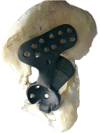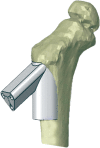Clinical Applications of 3-Dimensional Printing Technology in Hip Joint
- PMID: 31321905
- PMCID: PMC6712410
- DOI: 10.1111/os.12468
Clinical Applications of 3-Dimensional Printing Technology in Hip Joint
Abstract
Three-dimensional (3D) printing is a digital rapid prototyping technology based on a discrete and heap-forming principle. We identified 53 articles from PubMed by searching "Hip" and "Printing, Three-Dimensional"; 52 of the articles were published from 2015 onwards and were, therefore, initially considered and discussed. Clinical application of the 3D printing technique in the hip joint mainly includes three aspects: a 3D-printed bony 1:1 scale model, a custom prosthesis, and patient-specific instruments (PSI). Compared with 2-dimensional image, the shape of bone can be obtained more directly from a 1:1 scale model, which may be beneficial for preoperative evaluation and surgical planning. Custom prostheses can be devised on the basis of radiological images, to not only eliminate the fissure between the prosthesis and the patient's bone but also potentially resulting in the 3D-printed prosthesis functioning better. As an alternative support to intraoperative computer navigation, PSI can anchor to a specially appointed position on the patient's bone to make accurate bone cuts during surgery following a precise design preoperatively. The 3D printing technique could improve the surgeon's efficiency in the operating room, shorten operative times, and reduce exposure to radiation. Well known for its customization, 3D printing technology presents new potential for treating complex hip joint disease.
Keywords: Hip Joint; Patient-Specific Modeling; Printing, Three-Dimensional; Prosthesis Design.
© 2019 The Authors. Orthopaedic Surgery published by Chinese Orthopaedic Association and John Wiley & Sons Australia, Ltd.
Figures







References
-
- Bagaria V, Rasalkar D, Bagaria SJ, Ilyas J. Medical Applications of Rapid Prototyping—a New Horizon. London, UK: IntechOpen Limited, 2011. 10.5772/20058. - DOI
-
- Gross BC, Erkal JL, Lockwood SY, Chen C, Spence DM. Evaluation of 3D printing and its potential impact on biotechnology and the chemical sciences. Anal Chem, 2014, 86: 3240–3253. - PubMed
-
- Zerr J, Chatzinoff Y, Chopra R, Estrera K, Chhabra A. Three‐dimensional printing for preoperative planning of total hip arthroplasty revision: case report. Skeletal Radiol, 2016, 45: 1431–1435. - PubMed
Publication types
MeSH terms
LinkOut - more resources
Full Text Sources
Other Literature Sources
Research Materials

